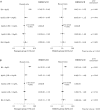Age and anemia management: relationship of hemoglobin levels with mortality might differ between elderly and nonelderly hemodialysis patients
- PMID: 25150218
- PMCID: PMC4240181
- DOI: 10.1093/ndt/gfu272
Age and anemia management: relationship of hemoglobin levels with mortality might differ between elderly and nonelderly hemodialysis patients
Abstract
Background: The elderly hemodialyzed population is growing. However, little is known about the relationship between hemoglobin level and survival according to age. We investigated the effect of age on the relationship between hemoglobin and survival within the Japan Dialysis Outcomes and Practice Patterns Study (DOPPS) cohort.
Methods: We enrolled the entire Japan DOPPS phases 3 and 4 population. Patients were divided by the age of 75 years into two groups. Cox's proportional hazard model was used with hemoglobin at every 4 months treated as a time-dependent variable. The interaction of age and hemoglobin was analyzed.
Results: We included 3341 patients in the analyses. The primary outcome occurred in 567 patients during the median follow-up of 2.64 years. Hemoglobin of entire population was 10.3 ± 1.3 g/dL. The median of epoetin dose was 3000 IU/week. Interaction was found between ages stratified by the age of 75 years and hemoglobin values (P = 0.045) with use of Cox's proportional hazard model. The nonelderly population had poorer prognosis with hemoglobin <10 g/dL, while elderly population only with hemoglobin <9 g/dL. For both hemoglobin strata <9, ≥9 and <10 g/dL, interactions between age and hemoglobin were significant. Subgroup analysis indicated that interaction between age and Hb levels was observed only in the nondiabetic nephropathy group. Several sensitivity analyses demonstrated a similar trend with the original analyses and reinforced the robustness.
Conclusions: The elderly population might tolerate low hemoglobin levels. Our findings open the way for further investigation of individualized anemia management.
Keywords: aged population; anemia management; individualized therapy; mortality.
© The Author 2014. Published by Oxford University Press on behalf of ERA-EDTA.
Figures



Similar articles
-
Anemia management and association of race with mortality and hospitalization in a large not-for-profit dialysis organization.Am J Kidney Dis. 2009 Sep;54(3):498-510. doi: 10.1053/j.ajkd.2009.05.007. Epub 2009 Jul 23. Am J Kidney Dis. 2009. PMID: 19628315
-
Relationship between responsiveness to erythropoiesis-stimulating agent and long-term outcomes in chronic hemodialysis patients: a single-center cohort study.Int Urol Nephrol. 2014 Jan;46(1):151-9. doi: 10.1007/s11255-013-0494-z. Epub 2013 Jun 27. Int Urol Nephrol. 2014. PMID: 23807369
-
2008 Japanese Society for Dialysis Therapy: guidelines for renal anemia in chronic kidney disease.Ther Apher Dial. 2010 Jun;14(3):240-75. doi: 10.1111/j.1744-9987.2010.00836.x. Ther Apher Dial. 2010. PMID: 20609178
-
The importance of iron in long-term survival of maintenance hemodialysis patients treated with epoetin-alfa and intravenous iron: analysis of 9.5 years of prospectively collected data.BMC Nephrol. 2009 Feb 26;10:6. doi: 10.1186/1471-2369-10-6. BMC Nephrol. 2009. PMID: 19245700 Free PMC article.
-
Should the target hemoglobin for patients with chronic kidney disease treated with erythropoietic replacement therapy be changed?Semin Dial. 2005 Jan-Feb;18(1):22-9. doi: 10.1111/j.1525-139X.2005.18105.x. Semin Dial. 2005. PMID: 15663760 Review.
Cited by
-
Characterising differences in red blood cell usage patterns between healthcare sectors in South Africa: 2014-2019.Blood Transfus. 2022 Jul;20(4):299-309. doi: 10.2450/2021.0209-21. Epub 2021 Nov 29. Blood Transfus. 2022. PMID: 34967724 Free PMC article.
-
Association of hemoglobin levels with cause-specific and all-cause mortality among older adults: a prospective cohort study.Front Public Health. 2024 Nov 18;12:1435283. doi: 10.3389/fpubh.2024.1435283. eCollection 2024. Front Public Health. 2024. PMID: 39624407 Free PMC article.
-
The Impact of CKD Anaemia on Patients: Incidence, Risk Factors, and Clinical Outcomes-A Systematic Literature Review.Int J Nephrol. 2020 Jul 1;2020:7692376. doi: 10.1155/2020/7692376. eCollection 2020. Int J Nephrol. 2020. PMID: 32665863 Free PMC article.
-
Relationship between Hemoglobin Levels Corrected by Interdialytic Weight Gain and Mortality in Japanese Hemodialysis Patients: Miyazaki Dialysis Cohort Study.PLoS One. 2017 Jan 3;12(1):e0169117. doi: 10.1371/journal.pone.0169117. eCollection 2017. PLoS One. 2017. PMID: 28046068 Free PMC article.
-
Anemia biomarkers and mortality in hemodialysis patients with or without diabetes: A 10-year follow-up study.PLoS One. 2023 Jan 31;18(1):e0280871. doi: 10.1371/journal.pone.0280871. eCollection 2023. PLoS One. 2023. PMID: 36719878 Free PMC article.
References
-
- Pascual J, Teruel JL, Moya JL, et al. Regression of left ventricular hypertrophy after partial correction of anemia with erythropoietin in patients on hemodialysis: a prospective study. Clin Nephrol. 1991;35:280–287. - PubMed
-
- Foley RN, Parfrey PS, Harnett JD, et al. The impact of anemia on cardiomyopathy, morbidity, and and mortality in end-stage renal disease. Am J Kidney Dis. 1996;28:53–61. - PubMed
-
- Regidor DL, Kopple JD, Kovesdy CP, et al. Associations between changes in hemoglobin and administered erythropoiesis-stimulating agent and survival in hemodialysis patients. J Am Soc Nephrol. 2006;17:1181–1191. - PubMed
-
- Johansen KL, Finkelstein FO, Revicki DA, et al. Systematic review of the impact of erythropoiesis-stimulating agents on fatigue in dialysis patients. Nephrol Dial Transplant. 2012;27:2418–2425. - PubMed
-
- Kalantar-Zadeh K, Kopple JD, Block G, et al. Association among SF36 quality of life measures and nutrition, hospitalization, and mortality in hemodialysis. J Am Soc Nephrol. 2001;12:2797–2806. - PubMed
Publication types
MeSH terms
Substances
LinkOut - more resources
Full Text Sources
Other Literature Sources
Medical

